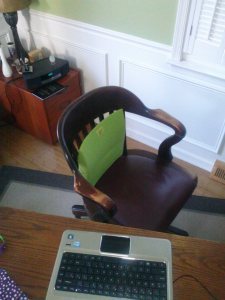Have A Seat, Then Get Up & Stretch

Heart-opening stretch.
I woke up this morning with a stiff neck. My go-to reason when my neck muscles are as tight as a rubber band in a 12-year-old’s slingshot is “I slept wrong.” Either I used too many pillows; pillow too flat; turns too turbulent. But, really, I’ve been sleeping for thousands of nights now, and you would think I’d know how not to “sleep wrong.” Besides, muscles this taut take more than one night’s “rest.” The reason more likely is “I wrote wrong.” Grammar, plot structure, and narrative aside, there is a wrong way and a right way to write.
I’ve been sitting at my desk for many days running. Creating new stories is usually very relaxing for me. Even the research phase sets me in a placid zone. But once I hit the rewrites or edits, the shoulders creep up into my neck, I slouch to get closer to the screen (as if there’s a dangling participle lurking somewhere on the screen), and I become affixed to the seat in an obsessive marathon of “getting it done.” WRONG.
Of course, as any published author will attest, the first step to being successful is to sit down and write. Jonathan Maberry, a multiple Bram Stoker award winning author and horror novelist said precisely that last week in an interview with Galleycat. I believe his exact words were “get your butt in a chair and write.” That’s excellent advice, and he offers more insight into the routine of a successful writer. However, what a lot of writing advice neglects to tell us writers after the “sit down” part is “get up and stretch.”
I know that I spend hours seated. I’ve actually reached a point where I need to remind myself to get up and stretch. When I sit for too long, my muscles rebel and constrict. Ultimately, I begin to associate sitting down to write with discomfort. Writing as a tortured exercise is a romantic notion but also a silly byproduct of simply sitting too long. Get out of your seat. You don’t have to go far. Stand next to your desk. Stretching stimulates the circulation. Blood flows more freely through the heart and brain and outward to the appendages. Muscles are massaged and aerated. Stiffness is dispelled. I would contend that limber muscles contribute to limber imagination. Try it.

This is my desk chair. It’s empty because I’m stretching. Try it.
Here’s what every writer should do every 30 minutes:
Stand up at your desk.
Inhale, and reach into the air as high as you can. Get up on your toes. Grasp above your head for the success that is within reach. (There’s some positive visualization in this effort as well.)
Exhale and slowly windmill our arms down and back behind you. Push out your chest. This is the heart-opening yoga position that’s pictured. Writing comes from your heart. It will be supplemented by the information in your head. But your heart is your source. Open it.
Hands on hips, bend to one side and then the other. Stretch up from your waist and through your ribs. Breathe.
Exhale and touch your knees. Touching your toes is great if you can do it but, generally, is overrated. We’re writers, not gymnasts.
Dangle your arms. Relax.
Stand up, breathe in, smile. Have a seat and get back to work.
Repeat in 30 minutes.
I guarantee a more productive writing day.
Best Wishes,
Kellyann
Read THE GENIE IGNITES today.
On Kindle. On Nook.





